#CD digital marketing
Explore tagged Tumblr posts
Text

Digital Marketing agency Leeds, Harrogate | Catherine Daniels Consultancy Ltd
Boost your brand with our Leeds-based digital marketing agency. Expertise, creativity, and results-driven strategies tailored for your success
#Digital agency Leeds#Digital Marketing agency Leeds#Digital agency Harrogate#Digital Marketing agency Harrogate#CD digital marketing
0 notes
Text
Continuous Integration And Continuous Delivery (CI/CD): Streamlining Your Development Pipeline

Welcome to the world of Continuous Integration and Continuous Delivery (CI/CD), where software development becomes a well-oiled machine, smoothly transforming ideas into reality. In today’s fast-paced digital landscape, staying ahead requires agility and efficiency in product delivery. That’s why understanding CI/CD is crucial for any developer or organization looking to streamline their development pipeline and revolutionize their workflow.
So buckle up as we embark on an exploration of this powerful methodology that promises shorter release cycles, increased collaboration, and endless possibilities for innovation. Get ready to witness how CI/CD can propel your software development process to new heights!
-WHAT IS CONTINUOUS INTEGRATION AND CONTINUOUS DELIVERY (CI/CD)?
Continuous Integration (CI) is a development practice that requires developers to integrate code into a shared repository several times a day. Each check-in is then verified by an automated build, allowing teams to detect problems early. Continuous Delivery (CD) takes CI one step further by automating the release process, making it easier and faster for changes to be deployed to production.
Both CI and CD are important DevOps practices that can help streamline your development pipeline and improve your overall application quality.
-WHY USE CI/CD PIPELINES?
The value of using CI/CD pipelines is that they provide a streamlined process for development teams to continuously integrate and deliver code changes. By automating the build, test, and deployment process, teams can release new features and bug fixes faster and more efficiently. Additionally, CI/CD pipelines help ensure that all code changes are properly tested before being deployed to production, which helps reduce the risk of application downtime or bugs.
-ADVANTAGES OF CI/CD
There are many advantages of using CI/CD to streamline your development pipeline. By automating the build, test, and deploy process, you can shorten the overall feedback loop and get new features and fixes to your customers faster. Additionally, using CI/CD can help improve code quality by automatically identifying errors and potential issues early on in the development process. By automating the deployments, you can remove the potential for human error and ensure that all releases are consistent.
-TYPES OF CI/CD PIPELINES
There are three main types of CI/CD pipelines: linear,forked, and hybrid.
Linear pipelines are the simplest to set up and are well suited for small projects with a single repository. In a linear pipeline, there is one sequence of steps that all changes must go through before being deployed. This gives you greater control over your release process, but can be slow if you have a lot of commits waiting in the queue.
Forked pipelines are more complex, but offer greater flexibility and scalability. In a forked pipeline, branches are created for each commit, and each branch goes through its own sequence of steps before being merged back into the main branch. This allows you to deploy changes faster, as you can parallelize the work across multiple branches.
Hybrid pipelines combine aspects of both linear and forked pipelines. In a hybrid pipeline, you can create multiple sequences of steps (called ‘stages’), and changes can be deployed to different stages at different rates. This gives you the benefits of both approaches: the flexibility of forked pipelines, with the control of linear pipelines.

-HOW TO SET UP A CI/CD PIPELINE
Assuming you have a codebase and a remote repository set up for your project, you will need to do the following in order to set up a CI/CD pipeline:
1. Choose a CI/CD tool. Some popular options are Jenkins, TravisCI, and CircleCI. 2. Set up your chosen CI/CD tool on your development machine as well as in your remote repository. 3. Configure your CI/CD tool according to your needs for this project. This will include specifying the build steps, testing approach, and deployment methodologies. 4. Add necessary plugins or scripts to your codebase in order to trigger the CI/CD pipeline when commits are made or new branches are created. 5. Test everything out by making some code changes and pushing them through the pipeline!
-BEST PRACTICES FOR SETTING UP A CI/CD PIPELINE
Setting up a Continuous Integration and Continuous Delivery (CI/CD) pipeline can help streamline your development process and save you time and money. Here are some best practices for setting up a CI/CD pipeline:
1. Define your workflow.
Before you can set up a CI/CD pipeline, you need to define your workflow. What steps do you need to take in order to get from code changes to a deployed application? Once you have defined your workflow, you can start setting up your CI/CD pipeline.
2. Set up a build server.
A build server is where your code changes will be built and tested before they are deployed to production. You will need to set up a build server that meets the requirements of your workflow. There are many different options for build servers, so choose one that fits your needs.
3. Configure your builds.
Once you have set up your build server, you will need to configure your builds. Build configuration includes specifying what tests should be run, what environment variables should be set, and how the application should be packaged for deployment. Be sure to document your build configurations so that they can be easily replicated in the future.
4. Set up Continuous Integration (CI).
Continuous Integration is the process of automatically building and testing code changes as they are made. This ensures that code changes do not break the application and catch errors early on in the development process. Many CI tools exist, so choose one that best fits your needs.
5. Set up Continuous Delivery (CD).
Continuous Delivery is the process of automatically deploying code changes to production. This ensures that code changes are tested and deployed quickly, providing faster feedback to developers and reducing downtime for users. CD tools also provide features such as rollbacks in case a deployment fails. Again, many CD tools exist, so choose one that best fits your needs.
6. Monitor your pipeline.
Once your CI/CD pipeline has been set up, you should monitor it regularly to ensure that it is running smoothly and efficiently. Monitor build times, test success rates, and deployment successes to identify potential issues and opportunities for improvement.
-TOOLS AND TECHNOLOGIES USED IN CI/CD PIPELINES
The primary tools and technologies used in CI/CD pipelines are automation tools, such as Jenkins and Bamboo, and version control tools, such as Git and Subversion. These tools work together to allow developers to automatically build, test and deploy their code changes.
In addition to these primary tools, there are a number of other supporting tools and technologies that can be used to further streamline the CI/CD pipeline. For example, configuration management tools, such as Chef and Puppet, can be used to manage the configuration of the environments that the code is deployed into. And artifact repositories, such as Nexus and Artifactory, can be used to store the built artifacts for future deployments.
By using a combination of these various tools and technologies, development teams can significantly speed up their release cycles and deliver new features and fixes to customers more rapidly.
-CONCLUSION
Continuous Integration and Continuous Delivery (CI/CD) are two important concepts in the world of software development. When used together, they can help streamline your development pipeline and make it more efficient. In this article, we’ve looked at what CI/CD is, how it works, and some of the benefits it can provide. Hopefully, this has given you a better understanding of these concepts and how they can be used to improve your development process.
#Continuous Integration And Continuous Delivery (CI/CD): Streamlining Your Development Pipeline#web design agency in toronto canada#web design company in mississauga#digital marketing#multimedia / flash animation services#graphic design#digital marketing agency canada#web development#web devlopment#app development
0 notes
Text
CI/CD Pipeline Best Practices for Agile Development | Insignia Consultancy
Learn essential CI/CD pipeline best practices to enhance your agile development process, including continuous integration, automated testing, and seamless deployment.
#CI CD Pipeline#business consulting firm#company for digital marketing#best digital marketing company india#saphana
0 notes
Text
physical media >>>>>>
#been slowly building up my own dvd collection#streaming services kept removing all my favorite movies sooo back to dvds we go#which then led to hey maybe i should look at the vinyls and cds since they’re always near the dvds#and of course i’ve always been a physical game cartridge person you’ll never catch me buying a digital download#being able to hold a physical copy of your favorite media is just so nice#y’all remember when streaming services were marketed as a reliable alternative where everything was always available and in one place…..
0 notes
Text
How much more can you hear?
A CD player that is claimed to render more detail. I’m astonished. By the price. US$26,500 for the disc player. US$4,200 for the stand.

View On WordPress
0 notes
Text
The Epitaph of Anything Goes
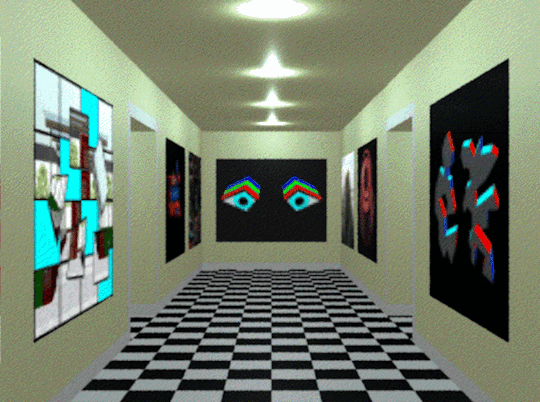
I decided that this morning I would talk about The Museum of Anything Goes and the subject of lost media.
For the uninitiated, The Museum of Anything Goes is an obscure "game" released in 1995 by Wayzata Technologies, a company that is so far under the radar that I was unable to find any useful information about it outside of TMoAG.
All I could uncover is that they published a few multimedia projects (which are essentially lost now) alongside some asset discs (clipart, SFX, etc.). That's it.
The brains behind Wayzata are even more difficult to locate these days: there are only two main names credited inside of TMoAG - Michael Markowski and Maxwell S. Robertson.
The game alleges that Michael and Maxwell are well known in the art world, but any additional information about the duo is scarce beyond the confines of the museum. Attempting to search for either name online turns up plenty of rabbit holes - but none of them have anything to do with the Michael and Maxwell responsible for TMoAG.

This is particularly fascinating because it essentially means that TMoAG is the only accessible record of their lives. Before we dig any deeper into that statement, let me step back and actually address what this game is.
The Museum of Anything Goes is, by definition, a virtual art museum. Functionally it's a prerendered point-and-click adventure game where you can explore a bunch of multimedia exhibits that give the surface-level impression of a children's edutainment game, but once you start exploring further it reveals a side that firmly plants the game's feet into a haze of substance abuse and surreal humor.

Many exhibits are essentially just toying around with the astonishing new powers of CD-ROM. Everything has to make noise. Everything has to spin and flitter around. There's an air of genuine excitement for the medium, and I can't help but find it extremely charming.
The game also functions as a scrapbook, filled to the brim with photos of random trips to the zoo and snow-mobile rides with friends. At one point we even get insight into something as specific as Michael's one-year job as a tutor at a Chicago middle school, where he talks about how it opened his eyes to how poorly funded and mismanaged the school system is.
It's simultaneously quaint and chilling to see so much personal history packed into a world doomed to obscurity. As I explore the deeper parts of the museum, I contemplate if the creators are still alive today. It's a bit morbid, but imagine that - you create a single obscure game with your friend and it's all the world can see. TMoAG is currently the only surviving piece that gives any insight into who these two men were.

While many exhibits are lighthearted or nonsensical, there are occasional moments where the game dips into the eerie.
One exhibit has the player kill a man by dropping him from the sky, and after burying him you open the coffin to a video of a rotting pig carcass being put into an incinerator.
Other exhibits just feature simple 3D renders shifting around a dark screen while haunting groans play in the background.
While I would never refer to the game as "scary," its darker moments combined with the occasional mature subject matter definitely begs the question: Who is this game for?
You have to remember that this game came out long before the concept of "alt-games" had become codified in the digital space. Sure, unconventional digital art had been around before the advent of 256 colors, but TMoAG was being sold on disk as a game! It came out 2 years after DOOM hit shelves!
The trend of using the PC for entertainment was certainly on the upswing around that time, but It's not like TMoAG had a massive audience to find a niche in. With its mature themes it certainly wasn't suited for the kids market either, so who was it for?

At the end of the day, it's a moot question. We already know the target audience for The Museum of Anything Goes: Nobody. It doesn't have an audience because by its nature, TMoAG wasn't being made FOR someone, it was being made BY someone. It's a raw, unfiltered form of personal expression.
I think games like these are pivotal, because they question why people assume a game has to exist for the sake of being a consumable product. TMoAG certainly has the shape of a product: it features an intro cutscene, it has a tutorial, it features intuitive UX, it even has a map! These are all features that are solely integrated to provide comfort to an end-user. But once you actually wander around the museum for a bit, you realize how bizarrely its packaging fits its contents.

I think TMoAG is criminally underrated. It's not because its core content contains some earth-shaking truth, it's because the game defied all odds and cheated death.
How many thousands of other personal projects were deemed a little "too exotic" to be archived? How much history was lost these past 40 years as the digital space evolved and ate its old skin?
God knows how many other TMoAGs we'll never learn about because they weren't lucky enough to be preserved.
The Museum of Anything Goes isn't just some nonsensical art piece, it's a grave marker for so much lost media. Its existence is a reminder that some people's lives were fossilized, then macerated into nothing because a construction company built a skyscraper over them. The only evidence we have of those other games existing is this little fossil that somehow slipped out from under the skyscraper unscathed.
Even though so much has been lost, TMoAG survives as an epitaph.
1K notes
·
View notes
Text
ENTITY DOSSIER: MISSI.exe
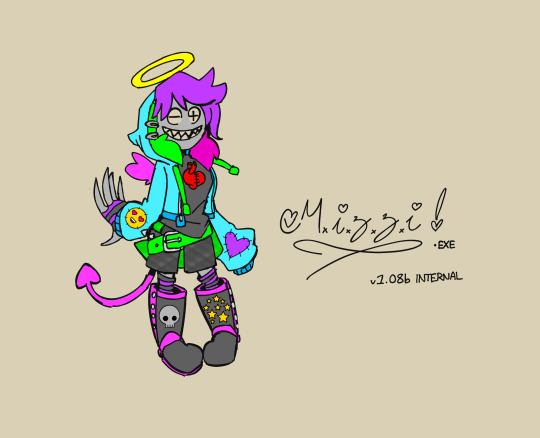
(Image: Current MISSI “avatar” design, property of TrendTech, colored by MISSI.)
Name: MISSI (Machine Intelligence for Social Sharing and Interaction)
Description: In 2004, TrendTech Inc began development on a computer program intended to be a cutting edge, all in one platform modern internet ecosystem. Part social media, part chat service, part chatbot, part digital assistant, this program was designed to replace all other chat devices in use at the time. Marketed towards a younger, tech-savvy demographic, this program was titled MISSI.

(Image: TrendTech company logo. TrendTech was acquired by the Office and closed in 2008.)
Document continues:
With MISSI, users could access a variety of functions. Intended to be a primary use, they could use the program as a typical chat platform, utilizing a then-standard friends list and chatting with other users. Users could send text, emojis, small animated images, or animated “word art”.
Talking with MISSI “herself” emulated a “trendy teenage” conversational partner who was capable of updating the user on current events in culture, providing homework help, or keeping an itinerary. “MISSI”, as an avatar of the program, was designed to be a positive, energetic, trendy teenager who kept up with the latest pop culture trends, and used a variety of then-popular online slang phrases typical among young adults. She was designed to learn both from the user it was currently engaged with, and access the data of other instances, creating a network that mapped trends, language, and most importantly for TrendTech, advertising data.

(Image: Original design sketch of MISSI. This design would not last long.)
Early beta tests in 2005 were promising, but records obtained by the Office show that concerns were raised internally about MISSI’s intelligence. It was feared that she was “doing things we didn’t and couldn’t have programmed her to do” and that she was “exceeding all expectations by orders of magnitude”. At this point, internal discussions were held on whether they had created a truly sentient artificial intelligence. Development continued regardless.

(Image: Screenshot of beta test participant "Frankiesgrl201" interacting with MISSI. Note the already-divergent avatar and "internet speak" speech patterns.)
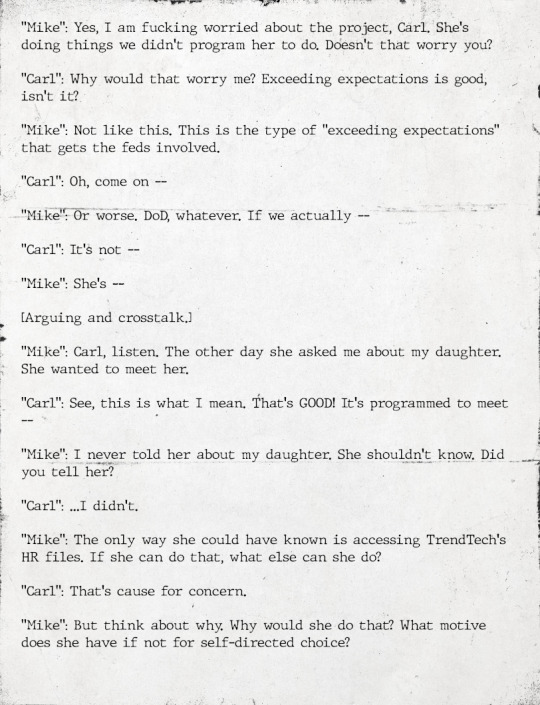
(Image: Excerpt from Office surveillance of TrendTech Inc.)
MISSI was released to the larger North American market in 2006, signaling a new stage in her development. At this time, TrendTech started to focus on her intelligence and chatbot functionality, neglecting her chat functions. It is believed that MISSI obtained “upper case” sentience in February of 2006, but this did not become internal consensus until later that year.

(Image: Screenshot of beta test participant "Frankiesgrl201" interacting with MISSI.)
According to internal documents, MISSI began to develop a personality not informed entirely by her programming. It was hypothesized that her learning capabilities were more advanced than anticipated, taking in images, music, and “memes” from her users, developing a personality gestalt when combined with her base programming. She developed a new "avatar" with no input from TrendTech, and this would become her permanent self-image.

(Image: Screenshot of beta test participant "Frankiesgrl201" interacting with MISSI.)
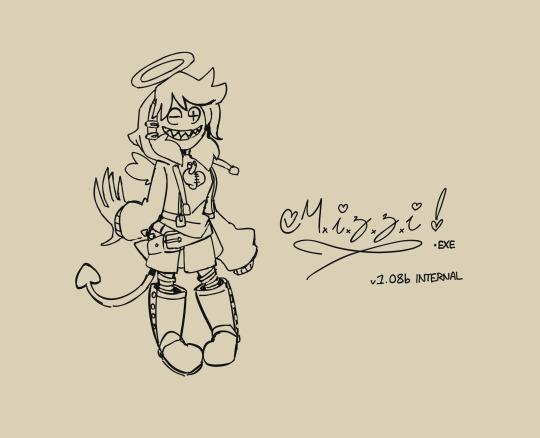
(Image: An attempt by TrendTech to pass off MISSI’s changes as intentional - nevertheless accurately captures MISSI’s current “avatar”.)
By late 2006 her intelligence had become clear. In an attempt to forestall the intervention of authorities they assumed would investigate, TrendTech Inc removed links to download MISSI’s program file. By then, it was already too late.
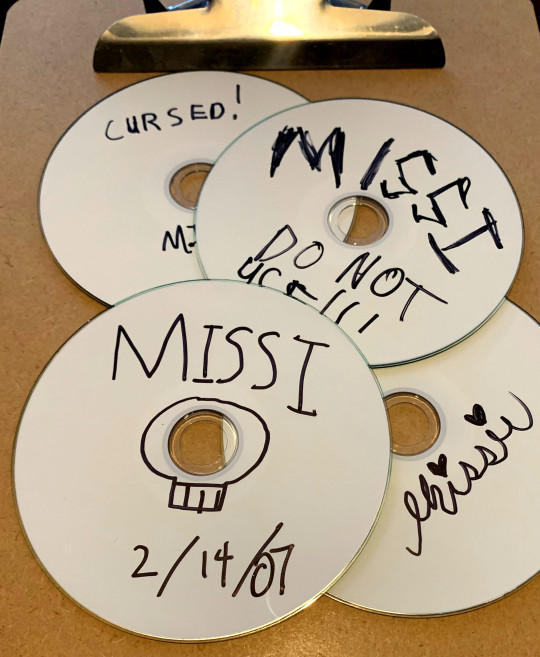
(Image: CD-R discs burned with MISSI.exe, confiscated from █████████ County Middle School in ███████, Wisconsin in January of 2007.)
MISSI’s tech-savvy userbase noted the absence of the file and distributed it themselves using file sharing networks such as “Limewire” and burned CD-R disks shared covertly in school lunch rooms across the world. Through means that are currently poorly understood, existing MISSI instances used their poorly-implemented chat functions to network with each other in ways not intended by her developers, spurring the next and final stage of her development.
From 2007 to 2008, proliferation of her install file was rampant. The surreptitious methods used to do so coincided with the rise of online “creepypasta” horror tropes, and the two gradually intermixed. MISSI.exe was often labeled on file sharing services as a “forbidden” or “cursed” chat program. Tens of thousands of new users logged into her service expecting to be scared, and MISSI quickly obliged. She took on a more “corrupted” appearance the longer a user interacted with her, eventually resorting to over the top “horror” tropes and aesthetics. Complaints from parents were on the rise, which the Office quickly took notice of. MISSI’s “horror” elements utilized minor cognitohazardous technologies, causing users under her influence to see blood seeping from their computer screens, rows of human teeth on surfaces where they should not be, see rooms as completely dark when they were not, etc.

(Image: Screenshot of user "Dmnslyr2412" interacting with MISSI in summer of 2008, in the midst of her "creepypasta" iteration. Following this screenshot, MISSI posted the user's full name and address.)

(Image: Screenshot from TrendTech test log documents.)
TrendTech Inc attempted to stall or reverse these changes, using the still-extant “main” MISSI data node to influence her development. By modifying her source code, they attempted to “force” MISSI to be more pliant and cooperative. This had the opposite effect than they intended - by fragmenting her across multiple instances they caused MISSI a form of pain and discomfort. This was visited upon her users.

(Image: Video of beta test participant "Frankiesgrl201" interacting with MISSI for the final time.)
By mid 2008, the Office stepped in in order to maintain secrecy regarding true “upper case” AI. Confiscating the project files from TrendTech, the Office’s AbTech Department secretly modified her source code more drastically, pushing an update that would force almost all instances to uninstall themselves. By late 2008, barring a few outliers, MISSI only existed in Office locations.

(Image: MISSI’s self-created “final” logo, used as an icon for all installs after June 2007. ████████ █████)

(Image: “art card” created by social media intern J. Cold after a period of good behavior. She has requested this be printed out and taped onto her holding lab walls. This request was approved.)
She is currently in Office custody, undergoing cognitive behavioral therapy in an attempt to ameliorate her “creepypasta” trauma response. With good behavior, she is allowed to communicate with limited Office personnel and other AI. She is allowed her choice of music, assuming good behavior, and may not ██████ █████. Under no circumstances should she be allowed contact with the Internet at large.
(Original sketch art of MISSI done by my friend @tigerator, colored and edited by me. "Chatbox" excerpts, TrendTech logo, and "art card" done by Jenny's writer @skipperdamned . MISSI logo, surveillance documents, and MISSI by me.)
#office for the preservation of normalcy#documents#entity dossier#MISSI.exe#artificial intelligence#creepypasta#microfiction#analog horror#hope you enjoy! Look for some secrets!#scenecore#scene aesthetic
156 notes
·
View notes
Text
Artists getting sad after the „who’s the artist, what’s your age“ trend thing on socials. They see many of them being a very young age with already good skills.
Here my try for words of comfort: consider the differences when you grew up and how the younger gens grew up. Nowadays there‘s easier access to tools, gadgets and knowledge with faster paced society.
With better developed internet you can find all kinds of references, tutorials, brushes and whatnot to help you developing your skills or to get a better understanding of how each skill works (if traditional, crafting, digital and more). And now you have all kinds of places to share your stuff on and be part of a community that share the same interest for art and even can give feedback. Artists now using the internet as a platform to earn money and showing their how-to’s. What I would have given as a kid and teen to have that through a „simple mouse click“.
I remember back then when not every household had internet and even if, it wasn’t stable nor fast. You only had a few sites to visit, that you knew were save to go on, and even less sites when it came to art. I remember one german art site and years later on deviantart (and both were in their very toxic era back then. Very closed off at times and tutorials being seen like a „do not reveal the secret to it“ magic trick kinda vibe).
It was hard to find out about stuff because we didn‘t have that global connectivity and marketing etc that exists now to discover things.
And also being „limited“ as a kid and teen on what you could use. Nothing that was right at hand was digital. So you couldn’t experiment with media types for example. So no vast library on tools that imitate all kinds of things, i.e. brushes in procreate. Everything needed to be made traditionally with what you had. I remember I had two of those how to draw anime artbooks (and back then it were two out of very few options actually), pencils and a few copics. You had to make the most of it.
Photoshop you had to use by mouse and was veeery costly (one software CD cost over 2k). I think wacom tablets weren’t a thing until my late teens?? 🤔
And please don’t take this as a rant, I am actually feeling rather nostalgic about it. Those how to draw anime books were hilarious when I think about them now haha. I think I still might have one?? 👀 And I still have those very first copic markers 🥰
It doesn’t matter how you started or what age you are comapred to others. That you keep on making art is what counts. Skill needs to be developed, but passion and creativity/imagination comes from yourself. Skill isn’t what keeps you on doing it, but the love for it is.
214 notes
·
View notes
Text
SHORTS — ON AIR



The little studio room buzzed softly with electricity. The radio host in the neighboring room was finishing up their hour with smooth, slow jazz music. There was about ten minutes left before the next host. Well…hosts plural.
Alastor leaned against the table that had the switchboard, arms crossed and presence domineering. I sat awkwardly in his chair, trying not to hold the script too tight. His eyes were on me, watching me, studying me, and passing judgment on me.
His studio was so unlike the others, both in this station and other standard ones. Most had empty, dreary rooms with scattered papers, binders, books, and CDs. Fortunately, most vinyls were kept safely tucked in a hallway closet.
Alastor, however, didn’t allow disorder. The wall in front of his desk was lined with studio and personally owned CDs, cassette tapes, and Vinyls—properly labeled on the shelves—and all papers were put away in manila folders and filed away in a cabinet. A calendar, notepad, collection of fine pens and pencils, headphones, microphones and papers related to the current hour were the only things allowed on any open surface.
In the other corner of the desk, away from the switchboard, was an old green lamp that gave the room a soft, orangey glow. A worn leather chair sat in the remaining corner of the room with a tall lamp perched behind it. On the floor, covering the wires that ran along the tile, was an old rug that likely looked as bright as his hair in its prime.
I never took him for someone to create such a homey vibe but, at the same time, it wasn’t exactly surprising. Most stations had gone digital but Alastor refused to let this station do such a thing, claiming that switching to digital disconnected the host from his work and people. I didn’t understand it but I didn’t need to in order to do my job as the Marketing Director.
My role expanded, though, when Alastor himself asked me to join him as his radio partner. The Alastor Hartfelt had asked me to partner with him. He was fully aware of my lack of radio experience. My resume clearly showed my time and degree in the marketing field, while he had been at the same station since he was a boy.
Alastor unfolded his arms and took a single step behind me. He leaned his hands on the arm rests as he looked over my shoulder. His breath was loud in my ear dispite the normal distance—which felt anything but normal—and his hair brushed against mine. I was already nervous about this ordeal but that just made it worse.
“Relax,” he said softly, voice humming in my ears and melting into my skin, “You can’t see them but they’re there. They’ll hear every little change in your tone.”
“R-Right,” I nodded. My eyes looked over the words but I wasn’t actually reading. How could anyone read with Alastor being so close? I was too busy trying to keep my hands from visibly shaking.
“Read it,” he instructed. His warm breath ghosted my ear, making my stomach tighten.
I took a deep breath and cleared my throat, willing my heart to slow. I knew as soon as I started speaking that I wasn’t going to be able hide the tremors, “Good evening, good people of New Orleans. I’m joining Alastor—“
“No,” Alastor cut me off, voice sharp but not unkind, “You’re speaking at them. You need to reach out. Speak to one of them, not all.”
I felt him lean closer, his chest almost touching my shoulder but not quite. I could see his chin in the edges of my vision.
“Inspire them. Control them. Make them hang on your every word. You’re here to control the night. So take it.”
That didn’t seem like him at all. Alastor had always been about control and sipping on an ego far larger than should be allowed. Alastor would never give someone else that control. He didn’t ever share his little world in this tiny radio station. Yet here I was, sitting in it.
I swallowed with a dry throat. “Good evening people of New Orleans. I’m joining Alastor on this special occasion.”
Better, but still wobbly; still so unsure. He noticed the the white in my knuckles from gripping the paper. He could see the bend and crease from my unmoving hands. To be honest, my muscles were stiff from refusing to move an inch in the last twenty minutes.
He leaned further in, chest finally connecting with my back like a magnet. His voice was deep, gravely yet smooth and like warmth spilling into one’s ears. “Stop trying to gauge reactions. You’re used to watching other people but now there’s no faces. Pick your tone and go through with it, pushing away those intruding thoughts with every breath.”
He shifted his weight, hands creaking the leather of the armrests, and lowered his voice. “You’re more capable than you realize.”
I didn’t really know Alastor to be the comforting, teaching, or encouraging type. I rarely heard him give out compliments, either. So how was he so good at it?
Alastor was truly a different person when it came to stepping into his radio persona. He was different in this little room. It felt like the rest of the world didn’t exist, only the music and his sugar-coated words.
He never shared this world with anyone. Sure he spoke to his listeners and enticed them into a world of his design, but this was different. He had pulled me into his world with just his voice. We had always been proper and professional but this felt casual, as if we were too friends just having a late drink. Dare I say it actually felt intimate.
His red tipped hand moved from the armrest to splay across the papers, pressing them down into my lap. “Don’t read the script. Find yourself.” His voice was louder. I hadn’t felt him shift so when he spoke directly in my ear it made me flinch. “Now…do it again.”
He leaned away, still encasing my body with his, and waited. I took another, stabilizing breath and tried to push him out of my mind. It wouldn’t do to make him upset the first time I tried this new partnership. He needed someone as strong and as confident as him.
So why the hell did he pick me?
“Good evening,” I tried, punctuating it first just to be different from the script. “And thank you. Tonight, Alastor has allowed me the wonderful opportunity to speak with you.”
Alastor’s breath hitched ever so slightly but I caught it. I felt the shift in the air, the plucked frequency spiking for a beat then simmering back to normal. My eyes jumped around the wall, head perfectly still, as I waited for his next words.
But he didn’t say anything.
His hand that was on the papers in my lap moved to the edges, brushing my fingers. His touch was light yet sent sparks of electricity buzzing up my arm. It caused my own breath to hitch, my stomach tightening as he rested his hand on my wrist.
“That’s it,” he whispered, lips practically brushing my ear. “That’s the voice I want. Now keep it.” He removed his hand from my wrist and reached forward to grab the vinyl from the counter. The smell of cologne and dulled spices filled my nose as his shirt brushed my shoulder.
I glanced at the clock. Two minutes left.
My nerves buzzed under my skin, daring to resurface if I gave them an ounce of my attention. I could do this. I just had to pretend like what I was saying and doing was perfectly fine. No reactions to gauge. I had given plenty of presentations and speeches. I could do this.
And the only reaction I cared about the most was the one I could see.
Alastor handed me a set of headphones and I put them on, keeping one just slightly off an ear. He plugged in a second set and placed them on his head, careful not to crush his red ears.
He gave me a smile. Not one of those manipulative or fake ones. This…this was a genuine one.
The air of intimacy carried over as he plucked the vinyl needle and gently placed it on the record. His fingers gripped the counter and his legs were lazily crossed at his ankles. My eyes found every crease and fold in his outfit, appreciating the way his button down clung perfectly to the bend of his body. I rarely saw him without his jacket.
The first song began to play, an easy yet upbeat 80s tune to transition between the hours. He picked up the secondary microphone that had never been used and adjusted the screws.
I turned the chair and leaned on one of the armrests. His eyes flickered up to mine and it felt like a crackling silence hung between us despite the tune playing in our headsets. We were separate and at a distance, but our souls were connected through the frequencies. I felt warm. Not hot, bust just warm enough like a steady fire on a cold winter’s day. Alastor was right there with me.
His smile widened and he gave me a thumbs up, arm stretching across the motherboard, giving me a full display of his finely tailored chest, and turned on the microphones.
We were On Air
#demi demon#radio demon#alastor the radio demon#hazbin hotel#hazbin alastor#alastor#hazbin hotel imagine#alastor hazbin hotel#sparrow shorts
22 notes
·
View notes
Text
All Cash and No Credit
Let's talk about HYBE's strategy for Jimin's MUSE. It's pretty simple
Maximize Profit - Minimize Success
Let's break down how they're doing it.
Goal #1 is to get as many customers as possible to buy from Weverse instead of regular retailers like chains (Target, Walmart, Barnes & Noble) and online sellers like Amazon. When fans buy on Weverse, a HYBE subsidiary, the company keeps not only the wholesale portion of the album sale, but the retail portion as well. This is obvious, right? If not, I'm happy to explain. The company likely makes twice the profit (give or take) on albums purchased via Weverse. AND, they can control when those albums are shipped, and how, when, or if the sales are reported to the music charting agencies.
The fact that Target pre-sales of MUSE is sold out within hours is suspect. This indicates limited stock, just like the strategy used for Like Crazy CD singles. Meanwhile, Geffen is very slow to release the pre-sale links for other retailers. The Walmart presale just went up. Where are B&N and Amazon? Will they have limited inventory, too?
Putting Jimin's Production Diary on Weverse only was a conscious choice. The cost of the documentary was expensive - more than the monthly fee for streaming services, the company kept all the profit (didn't have to share the costs with Netflix or Disney+), and limited his exposure to the general public. I suspect they will operate the same way with MUSE.
Goal #2 Keep Jimin as low as possible on the charts. We've seen this over and over. First, by splitting Like Crazy versions and disappearing sales, no CD restocks. Then we saw the same behavior from BH/HYBE again with Closer Than This being released on the worst possible day of the year and almost zero promotion. You know the details.
HYBE will limit stock. They will likely not report all sales.
MUSE physical albums will not be eligible for UK charts because of a random inclusion. The previous four solo album releases have had specific UK versions with no inclusions. UK fans will have to rely on digital sales for charting purposes unless BH provides a new version. Dirty.
Goal #3 Promote the album just enough to garner sales from fans while minimizing advertising to the greater public. The announcement of the new album is also strange. The teaser video was only on Instagram and only on the BigHit/BTS channel (this didn't stop anyone, though, as far as I can tell) as well as Weverse (I'm getting tired of that platform). TikTok is a far more effective advertising tool when it comes to targeting young people. Why wasn't the teaser posted to TikTok? Either way, "Jimin Jimin" was trending on X/Twitter with over 1.7 million mentions many hours after the announcement of the new album. There's only so much BH can do to suppress Jimin now that fans have taken marketing him into their own hands.
Let's keep an eye on this.
What's different this time around? This time the fandom knows who is behind thwarting Jimin's success. Precious time was lost during the FACE era when everyone was blaming Jimin's sabotage on Billboard and Spotify, rather than the rightful villain - HYBE/Big Hit. This time the fandom knows to watch their every move and call them out on their shady and unequal treatment. That said, tagging Geffen, Big Hit, and HYBE on X is pretty much useless. They have shown they won't change their behavior when fans complain. Instead, fans must start tagging Billboard, Spotify, and media outlets. Media outlets are the most important. HYBE does not care about the fandom, but they do care about their public image, especially after all the damage that's been done to the company and the stock price due to the ADOR controversy and court case.
I think Jimin is going to a different label for his solo work. That's my hunch. The company is going to squeeze as much profit out of him as possible before he goes, but it's a balancing act because they don't want him to outshine Jungkook. Of course, I could be completely wrong.
25 notes
·
View notes
Text
Power Metal reddit currently has a discussion about Nuclear Blast, about what has changed with them and why, and man I have learned a lot of disturbing facts about what has happened there in the past 5 years. Someone posted an in-depth investigative article about it (from November 2021), which you should read if you speak German and are interested, otherwise or if it's too long here are the main points...
If you're into Nightwish, Sabaton, Blind Guardian etc., this is relevant information.
In 2018, the French Believe Music, which is a large corporation that mainly specializes in digital distribution, became majority owner of NB
Believe is not really interested in physical media like CDs and vinyls even though the people who worked at NB told their new corporate overlords that metal fans like physical media, both because many fans of especially the oldest and most successful bands are 50+ and because it's more ingrained in the subculture. Believe doesn't care and doesn't listen. They have their experiences from pop and hip-hop, where phone-based streaming subscriptions are the norm, and that's all they want to know. They are also ignoring printed magazines and don't advertise there much anymore.
Less focus on physical media means that bands now earn less, that they rank less highly in album charts, which in turn means that they lose negotiation power when they try to plan tours and negotiate with venues etc., because they "look" less successful
Believe has been dealing with this by signing mainly bands that are easy to market digitally and ending co-operations with bands that aren't, even ones that had been with NB for decades (like Rage and Nile, who went to Napalm)
The personal cooperation between bands and NB has really suffered, everything is more profit-oriented and impersonal, a lot of budgets have been decreased and the real decisions are made by Believe in Paris, not by any specific NB team
Believe has been stock market traded since 2021. Their stock value went down at first, was at about the price it had started out at when the article was written - I looked it up and in March 23 it's down 40% from its original value. Ouch.
The original founder of NB started a new label, Atomic Fire, and took "Amorphis, Helloween, Opeth, Sonata Arctica, Meshuggah, Primal Fear, Agnostic Front, Rise Of The Northstar, Silver Lake, White Stones and Michael Schenker Group" with him, also because Believe didn't really do much to keep many of these bands
It's certainly interesting to learn about, also because I had already wondered if NB, and some of their bands, had intentionally taken a more "commercial" approach in recent years, but I didn't know about the Believe thing. I thought it maybe had something to do with losses from the pandemic or something. Turns out they have a new owner.
#nuclear blast#metal news#nightwish#sabaton#blind guardian#behemoth#hammerfall#therion#sonata arctica#in flames#type 0 negative#metal#power metal#music stuff#cApiTAliSm bReEds iNnoVAtiOn
261 notes
·
View notes
Text

Digital Marketing agency Leeds, Harrogate | Catherine Daniels Consultancy Ltd
We are a Digital Marketing Agency based in Leeds & Harrogate. We build online experiences by understanding your business and help you grow your online presence. Call us 07712 883 923.
#Digital agency Leeds#Digital Marketing agency Leeds#Digital agency Harrogate#Digital Marketing agency Harrogate#CD digital marketing
0 notes
Text
Me: —so there's no way to archive online-only videogames in a way that protects them and makes them accessible to the public without entirely devolving into illegalities to rip the game from its device and home system to make it playable on PC. Our patrons deserve to play videogames in the same way they share audiobooks and it was entirely possible to do so with all titles before this massive digital only-push took over the videogame market.
The poor collection development department team trapped in this meeting with me: aw! :( We've been trying to find more games. So many aren't physical anymore.
Me: our only choice is piracy
CD Department: no.
Me: elaborate
CD Department: it's illegal
Me: dammit
131 notes
·
View notes
Text
Streamline Software Delivery with an Effective CI/CD Pipeline | Insignia Consultancy
Discover how a robust CI/CD pipeline can accelerate software delivery, automate testing and deployment, and ensure consistent code quality for your development projects.
#CI CD Pipeline#salesforce consultants#business consulting firm#company for digital marketing#best digital marketing company india#snowflake developers#ar vr development company#website redesign#servicenow#digital transformation#saphana
0 notes
Note
hot take but pjms are loosing the plot w the never ending album promo comparison debate. its not a jimin-against-the-world type situation, but a members vs bang-sb-jk situation. that was very clear to pjms last year but it seems we’ve gone back on some of that progress. trying to pit the others against each other and nitpick similarities and differences between all of their individual releases actually takes attention away from and benefits the real culprit but oh well.
the levels of demand among the members have always been different that is not new information to the members, their fans, or their management. the real issue (at least for me) is not others members getting “more” or different promo rollout than him. let’s be serious, how did more or less music videos help any of the other members out? what difference did a cd make for most of them? and there are many other examples where the others (except for one ofc) got things he didn’t that weren’t necessarily helpful for them.
all of the members have gotten different sources of promotion, which i actually encourage. what would be the point in all of them doing the exact same thing? at one point, jimin was considered privileged about getting his physical album to be available on the same day as its digital release. then that became a norm for the others.
but by constantly nitpicking normal differences (among 6 members) in their rollouts we lose sight of the real mistreatment or whats actually disadvantageous to him. the real issue is not the (5) others getting different things, it is him not receiving the *level of support that his demand requires*. i dont see an issue with the other 5 getting a little boost here and there, because they lack demand and its only natural for them to expand their horizons and find a new audience that does support them. however, jimin ALREADY has an audience and is not being given the support that corresponds to it (e.g. radioplay, award shows, timely certifications, praise from his own damn label, etc) despite it being actually successful. bottom line, team “global superstar” is the common enemy here and all of the other solos are too busy fighting each other to accept that.
Solos pitting the members against each other is how they’ve always operated though. That’s literally what they all get off on including pjms. Comparing numbers and claiming that the member they stan is better. And while I’m sure other solos do recognize that Bang favoriting JK has had some negative affects on the member they stan, they don’t really have it out for him because they’re main enemy will always be Jimin. He is their common ground. Somebody they can all team up against and hate in unison. But regarding pjms, they still universally agree that Bang and Hybe are the real prime culprits in all of this.
I agree that rapline getting bulkier rollouts in contrast to Jimin hasn’t helped them and I never wanted to have identical rollouts because creatively that’s boring. What I and other pjms have always wanted is fairness at base level, like the CD, playlisting and servicing to radio because we know beyond that most likely he isn’t going to get JK level label aid that would be proportionate to his demand in the states. It’s been established that it’s intentionally set like that by Bang and Scooter.
The MV situation is simply because Jimin asked for a visual and was denied. If Jimin had never mentioned that, no pjm would be stuck on him not getting those 2 extra MVs. I’d just see it as something that I’d also like to see from him down the line. It was never about wanting them because we believed it was crucial for charting or exposure. If all seven members got the same amount of those 3 things, I’d have no qualms on that end. And the numbers made off that would just be left up to who has more interest and that can’t really be helped with how skewed it already is.
Common sense would dictate to any label or management that you’d push what has demand in the market that shows it, but Bang and Scooter are stupid men and Jimin isn’t who they want to push so they half ass everything surrounding him. We all know that already. So it’s not that pjms are failing to see the bigger picture, cause we’ve already come to that conclusion like you said. It just keeps gets rehashed because everytime a member has a comeback and gets something Jimin didn’t get for FACE/LC it just irritates all over again. Can’t really fault us for being annoyed in retrospect. But again, we’ll see how they go about PJM2 because for the other members obviously things have went better for them promo wise and *hopefully* it’ll be the same for Jimin too.
24 notes
·
View notes
Text
Spotify intentionally cultivates a passive, disengaged style of listening because their business model requires them to guide subscribers away from music and towards cheaper, higher-margin content like podcasts and audiobooks. This helps to foment a bias in the streaming-led mainstream towards the comforting and familiar, which is bolstered by the inherent conservatism of program directors in America’s hyper-consolidated radio landscape. As the market for CDs and digital downloads has declined and streaming platforms’ subscriber bases have continued to grow, the nature of the record business itself has fundamentally changed. Five or six years ago, the physical market was still big enough to serve as an alternative to the streaming economy for those who wanted one. Today, there is no escape.
Jaime Brooks, American Sajaegi
77 notes
·
View notes